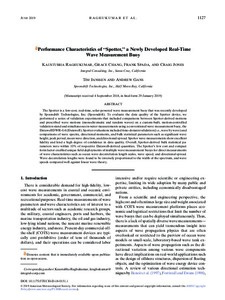| dc.contributor.author | Raghukumar, Kaustubha | |
| dc.contributor.author | Chang, Grace | |
| dc.contributor.author | Spada, Frank | |
| dc.contributor.author | Jones, Craig | |
| dc.contributor.author | Janssen, Tim | |
| dc.contributor.author | Gans, Andrew | |
| dc.date.accessioned | 2020-04-27T21:20:37Z | |
| dc.date.available | 2020-04-27T21:20:37Z | |
| dc.date.issued | 2019 | |
| dc.identifier.citation | Raghukumar, K., et al (2019) Performance Characteristics of “Spotter,” a Newly Developed Real-Time Wave Measurement Buoy. Journal of Atmospheric and Oceanic Technology, 36, pp.1127-1141. DOI: 10.1175/JTECH-D-18-0151.1 | en_US |
| dc.identifier.uri | http://hdl.handle.net/11329/1308 | |
| dc.identifier.uri | http://dx.doi.org/10.25607/OBP-816 | |
| dc.description.abstract | The Spotter is a low-cost, real-time, solar-powered wave measurement buoy that was recently developed by Spoondrift Technologies, Inc. (Spoondrift). To evaluate the data quality of the Spotter device, we performed a series of validation experiments that included comparisons between Spotter-derived motions and prescribed wave motions (monochromatic and random waves) on a custom-built, motion-controlled validation stand and simultaneous in-water measurements using a conventional wave measurement buoy, the Datawell DWR-G4 (Datawell). Spotter evaluations included time-domain validation (i.e., wave by wave) and comparisons of wave spectra, directional moments, and bulk statistical parameters such as significant wave height, peak period, mean wave direction, and directional spread. Spotter wave measurements show excellent fidelity and lend a high degree of confidence in data quality. Overall, Spotter-derived bulk statistical parameters were within 10% of respective Datawell-derived quantities. The Spotter’s low cost and compact form factor enabled unique field deployments of multiple wave measurement buoys for direct measurements of wave characteristics such as ocean wave decorrelation length scales, wave speed, and directional spread. Wave decorrelation lengths were found to be inversely proportional to the width of the spectrum, and wave speeds compared well against linear wave theory. | en_US |
| dc.language.iso | en | en_US |
| dc.rights | Attribution 4.0 International | * |
| dc.rights.uri | http://creativecommons.org/licenses/by/4.0/ | * |
| dc.subject.other | Wind wave measurement | en_US |
| dc.subject.other | Buoy observations | en_US |
| dc.subject.other | Surface observations | en_US |
| dc.subject.other | Surface waves | en_US |
| dc.subject.other | Renewable energy | en_US |
| dc.title | Performance Characteristics of “Spotter,” a Newly Developed Real-Time Wave Measurement Buoy. | en_US |
| dc.type | Journal Contribution | en_US |
| dc.description.refereed | Refereed | en_US |
| dc.format.pagerange | pp.1127-1141 | en_US |
| dc.identifier.doi | 10.1175/JTECH-D-18-0151.1 | |
| dc.subject.parameterDiscipline | Parameter Discipline::Physical oceanography::Waves | en_US |
| dc.subject.instrumentType | Instrument Type Vocabulary::wave recorders | en_US |
| dc.subject.instrumentType | Global positioning systemss (GPS) | en_US |
| dc.subject.dmProcesses | Data Management Practices::Data quality management | en_US |
| dc.bibliographicCitation.title | Journal of Atmospheric and Oceanic Technology | en_US |
| dc.bibliographicCitation.volume | 36 | en_US |
| dc.bibliographicCitation.issue | 6 | en_US |
| dc.description.sdg | 14.A | en_US |
| dc.description.eov | Sea state | en_US |
| dc.description.maturitylevel | TRL 9 Actual system "mission proven" through successful mission operations (ground or space) | en_US |
| dc.description.bptype | Manual (incl. handbook, guide, cookbook etc) | en_US |
| obps.contact.contactname | Kaustubha Raghukumar | |
| obps.contact.contactemail | kraghukumar@integral-corp.com | |
| obps.resourceurl.publisher | https://journals.ametsoc.org/doi/abs/10.1175/JTECH-D-18-0151.1 | en_US |
 Repository of community practices in Ocean Research, Applications and Data/Information Management
Repository of community practices in Ocean Research, Applications and Data/Information Management

